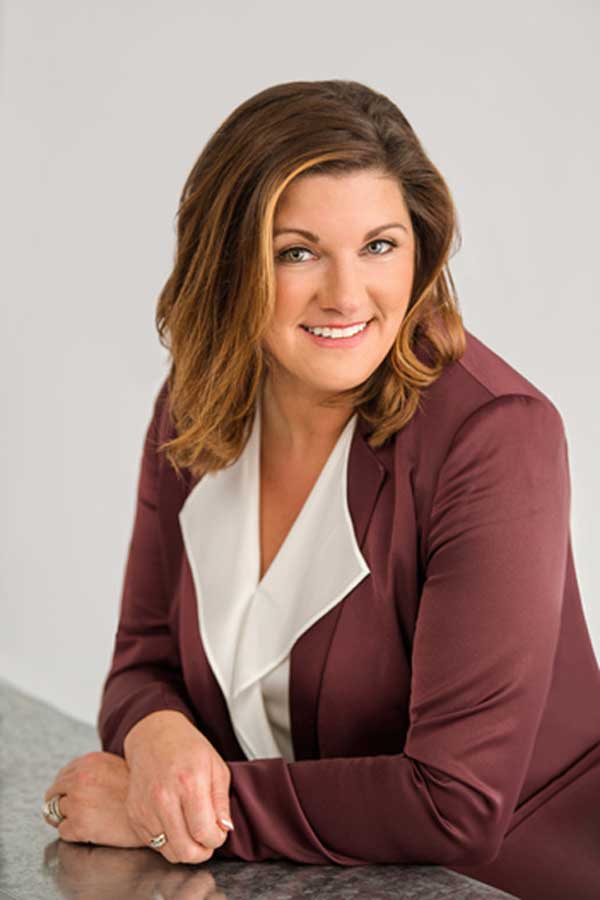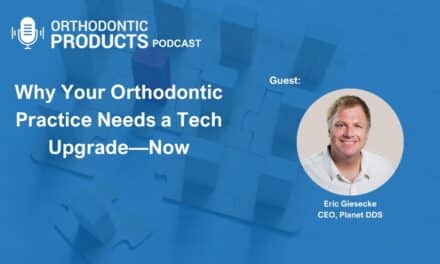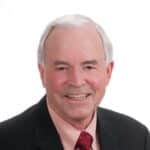It’s one thing to onboard a new technology into your orthodontic practice; it’s another to make it really work for you and maximize your return on investment. In this episode of the Orthodontic Products podcast, sponsored by Dental Monitoring, host Alison Werner talks to Michelle Shimmin, owner, consultant, and business analyst at Shimmin Consulting, about how to do just that.
- The pandemic exposed consumers to the benefits of virtual appointments and remote monitoring across different facets of their lives, including orthodontics. And as Shimmin explains, they don’t want to give that up.
- Shimmin discusses the importance of going all in if you are going to invest in a technology. “The most painful and challenging place to live is in that dabbling phase,” she says.
- When implemented correctly, Shimmin says, practices can experience “remarkable growth” without having to hire more staff, work more doctor days, or build a larger facility. And all this can be done while experiencing less stress, improving the patient experience, and setting the practice apart.
- Shimmin talks about how the artificial intelligence built into Dental Monitoring and how that gives practices actual data and metrics they can use to not only grow their business, but also improve both management and clinical workflows.
- Shimmin acknowledges that onboarding a new technology can be daunting, but there are ways to do it successfully. And the first step to success is good communication. She explains how a full-team meeting to discuss the “why” of implementing any new technology is key to getting staff buy-in. Too often staff members worry a new technology is going to create more work. As Shimmin points out, that doesn’t have to be the case here.
- As practices implement Dental Monitoring, they’re quickly going to see that they need to adjust their schedule template to maximize the benefits of the platform. Shimmin explains how to do this, and why it needs to start with building a digital workflow.
- Practices still tend to use remote monitoring technology solely for their clear aligner cases. Shimmin explains the benefits of using it with patients in brackets and wires and how to create a workflow and schedule these patient appointments.

Podcast Transcript
Alison Werner 0:10
Hello, this is the orthodontic products podcast. I’m your host Alison Werner. For this episode sponsored by dental monitoring. We have with us Michelle Shimmin, founder and owner of Shimman consulting. Now if you don’t know Michelle, she is an international lecturer, trainer and consultant who has been in the field of orthodontics for over three decades, teaching about orthodontic assisting marketing, financials treatment, coordinating and practice management. Michelle helps transform orthodontic offices on their systems to promote training, growth and success through a comprehensive practice approach. For this episode, we’re going to talk about how to really find success with remote monitoring technology, specifically the dental monitoring platform. It’s so easy to onboard a new technology, but to really make it work for your practice and to really get the return on investment that you’re hoping for. That takes some work. So Michelle is going to talk us through that. Here’s my conversation with Michelle. Michelle, thank you so much for joining me today.
Michelle Shimmin 1:01
Thank you for having me, Allison. I appreciate the opportunity to be here.
Alison Werner 1:05
Great. Okay, so let’s get started. For those who aren’t familiar with you and your firm. Can you talk about what orthodontists can expect if they work with you as a consultant?
Michelle Shimmin 1:13
Absolutely. My amazing team and I as business analysts, and coaches really look at their entire practice as a whole. And we address every area of opportunity from overhead expense management, rebuilding their schedule, templates, hiring and onboarding, to all internal processes and systems. We really fully customize our approach in partnership to the reality and the goals of each of our clients. And we most importantly, look to create clear channels for each person or role within the practice so that it can deliver the highest level of accountability and success. And this is really a unique approach and what sets our firm apart from any other consulting firm out there.
Alison Werner 2:04
Great. Well, I’m curious, from your experience, what are the key issues that are weighing on orthodontists today?
Michelle Shimmin 2:11
Well, definitely staffing and overhead have really been some of the biggest struggles, specifically over the last few years. And this, although starting to level off is definitely still a strong pain point for orthodontist and struggles that they’re experiencing right now within their business.
Alison Werner 2:32
No, I definitely have been hearing the same thing from when I’ve talked to doctors as well. So okay, so let’s go to today’s topic. And we’re going to focus on how to get the most out of the dental monitoring platform specifically. But before we dive into that, I want to talk about remote monitoring technology in general. Now, the pandemic really brought home the utility of the remote monitoring technology to keep connected with patients during shutdown. But as you’ve worked with practices in the years since those closures, what’s your take on the role of remote technology, remote monitoring technology today?
Michelle Shimmin 3:04
Right. So obviously, none of us had any options during the shutdown, we absolutely had to go virtual, we had to find solutions to stay connected with our patients. But I have said this from very early on those practices that use remote monitoring as a band aid, during the pandemic, and during the time that we were closed down, but then went back and reverted to what they’ve always done before are struggling. They really are not experiencing what technology can provide their business moving forward. In today’s day and age. And most importantly, Allison, our patients experienced the convenience and the benefits of that remote monitoring and the virtual appointments, and they their expectations are not going back. So I say it often but the most expensive words in business are we’ve always done it that way. And the most painful and challenging place to live, is in that dabbling phase. This is a reason that I’m so passionate about maximizing what technology provides us in business to really enhance and allow the practices to experience the largest return on investment and full benefits of that technology.
Alison Werner 4:28
Yeah, good points. You mentioned there that you know the patient experience with the technology and how they don’t necessarily want to go back to the way things were done before. But can you talk a little more about the specific benefits that practices can see with this technology?
Michelle Shimmin 4:44
Absolutely. So when it’s done correctly, practices can experience remarkable growth 15, 20, 30% without having to hire more staff work more Doctor days build a larger facility all While often experiencing less stress, this is the ultimate of efficiencies without even talking about the improved patient experience and utilizing that experience to turn our patients into our walking, talking referrals, and really setting ourselves apart.
Alison Werner 5:17
Great. Well, okay, so let’s dive into dental monitoring specifically. So when it comes to choosing a platform to work with, why do you see practices wanting to use dental monitoring?
Michelle Shimmin 5:29
Well, there is really a massive amount of talk and discussion about AI and how this is affecting every aspect of our lives in the in really the very near future, if it isn’t already, data is what is important to me. And I definitely look to the business that has actual practice data and metrics from that artificial intelligence to really back their claims. I have the privilege of working with practices and clients all over the world. So I have really seen an experienced what works, what doesn’t work, what’s real. And what is a claim that doesn’t have that same backing, it’s important to have technology that doesn’t require an actual team members eyes to view the patient photos, that did work when we didn’t have the option to see the patient in person. But when we’re talking about true technology, and allowing the technology to improve our business, overhead patient experience, are what we experienced throughout the day, every day, we have to really look at the technology that can do it for us. And we can depend on our technology to track closer than the naked eye quickly, as customized or as automated as we desire it to be. So I really have not seen a company that does it to the level of dental monitoring or to the accuracy. And as you can imagine, I look at and research many different companies out there that practices are using, and I really look to find the best one. There are a lot of claims with other companies out there. But the true AI is where practices can see the benefit. So I look for the data that backs that.
Alison Werner 7:27
Okay, so what are the first steps you recommend for practices working with the dental monitoring platform when they’re onboarding that system?
Michelle Shimmin 7:35
Excellent question, I just going to be transparent here, Allison and say that one practices choose a service or a technology, really any any out there, but such as dental monitoring, it can be a challenge, and the team members in needing to add on additional steps or processes can get very frustrated. But what I want to share with you is what the first steps needed are to be successful in that process. And we know through studies, outside of the industry of orthodontics, that 80% of those that fail at work, do so for one reason. And it’s because they cannot communicate well, in the workplace. It doesn’t say 80% of those fail at work because they don’t know how to do their job. So the number one step that I recommend and guide practices through is having an entire full team meeting and help having the team members participate and have it be an interactive process of the why behind incorporating dental monitoring technology into their business, what is it going to provide our our team, our schedule our doctor, our patients, because your team members really, truly will exude whatever message they feel internally. So I experienced often when doctors will bring a new technology into the business from a convention or an event. And the communication within the practice and the team members has not been there. We just bring it on and say Here we’re incorporating this. And that can be really frustrating for the team members. And that is not where you find and build a foundation of success to really set every team member up to be successful. I look to allow every team member to understand and believe in the why. Because I say that we passion is involved. It’s not high pressure sales, we truly should be able to have the power of influence through the passion that we have. And you tap into every team member to do that. So the first step is a full business meeting to talk about what the technology is, what it does, and the role for every position and the practice that they’ll have with education to your page. shins and influence to your patients, we want our patients to buy into this and understand the nine for them as well. So, you know, the practices that are not successful are the ones that rely solely on the treatment coordinator. As
Alison Werner 10:16
I love, I love that you acknowledge kind of the staffs frustration, which is having a new product or technology thrust on them, and then not having that conversation, because I think that’s missed. So often, it really does set everything up for failure. So to really maximize, you have to have that buy in and that understanding of why you’re incorporating it so well.
Michelle Shimmin 10:36
Team members provide the doctors, this just gives us more work this is this isn’t working the patients don’t just means more work for us. And that is that’s completely false. That should be not the case. And so this really leads into some of the struggles that we experience with practices. And then what are the next steps beyond that, for them to avoid that frustration, to where they they walk away saying it doesn’t work, or it’s not for our practice, or our patients don’t like this, they don’t want it.
Alison Werner 11:11
Okay, so you mentioned struggles there, what are the common struggles you observe with implementing this type of technology? Well, really,
Michelle Shimmin 11:19
the team members, not understanding truly what it is and what it does. So they’re not able to educate and influence the patients and the families to know what it will provide them in their busy schedule. studies that were done throughout the pandemic talked about motivators that mattered to today’s consumers. And it specifically reference in healthcare specific studies, that people consumers were looking for their practices to pivot to the times and to utilize technology to value the busy schedules of the families. And it showed that 72% of consumers were using that as a deciding factor to stay at the provider, it was a healthcare specific study. So 72%, were using those motivators and non information to decide if they were going to stay with their health provider. And 50% of those said that they would pay more for that service in that convenience. So it’s not a matter of our patients not wanting it and not seeing value in it, the struggle is when our team members aren’t, don’t have the ability as educators to influence the patients and understanding what it is another struggle is that practices don’t take the time to adjust internal protocols, to be able to understand the changes that need to be made internally. So they just bring on this new process without changing anything. And oftentimes, they’ll say, Well, we’re going to try it out, or we’re just going to see, you know how this works for us. And that’s a very painful, stressful place to live for the doctor and the team members. And that message is exuded to the patients that it doesn’t work. So we, you know, we create playbooks that really spell out based on the share of chair of specific treatment modalities. And the reality of that practice in what their current patient base is. There’s there’s a formula that we work on for our clients that talks about, what appointments do you start to eliminate first? How do you start to adjust your appointment sequence and your scheduling protocols, because you even those practices that commit from the beginning to go all in, there’s still a process with it. So that’s what we set up after understanding the reality and the historical data of each of our clients. And when we can do this on a stepping stone level, it really sets everybody up to be successful. And those are the practices that are seeing the benefit of it that are huge producing practices. And they haven’t had to add staff, they haven’t had to add more Doctor days. In fact, they can actually reduce days. Doctor has to be in the office seeing patients in person.
Alison Werner 14:26
Yeah, no, I’ve heard that as well with some of the kind of, I guess, the superusers. Yeah, yeah, exactly. So um, you talked about a little bit there. But you know, one of the things with implementing something like direct dental monitoring, is that you do have to shift your schedule and the way you’ve done things. So what do practices need to understand when adjusting their schedule template to maximize the benefits of dental monitoring?
Michelle Shimmin 14:52
Yeah, great question. So the first thing that we highly recommend is to build a digital workflow because So really what that’s going to do is give a visual to the team members on the patient’s flow or movement throughout the practice, and what person or position in the practice and when did they have that touch point with the patient, and what’s the protocol and each touch point. So that’s the first thing that we work on is creating that digital workflow. And then what we look to do after running the reports to understand the historical data of the practice, because it can’t be a one and done one size fits all, it truly has to be a custom setup to your practice. But we look to first look at what appointments can we start eliminating within the practice? What opportunities do we have through our dental monitoring, and an observation program is a huge opportunity with that, I often recommend, you know, typically an orthodontist season observation patient for two to three years before starting treatment, and they’re going to see him in person every six months. And so why can’t we utilize our virtual care through dental monitoring to see them, you know, monthly or quarterly, and do that for 12 months, and then see them at the next six month mark in person. So every 18 months, we’re seeing occupations one time in person, and we’re educating and communicating with them on a monthly or quarterly basis. So there’s a lot of increased opportunity, we obviously look to put all of our aligner cases immediately into our dental monitoring platform, we will look to put every new patient exam onto dental monitoring, I’m not a proponent of offering it as an add on or a extra buying process, I really feel passionate about the value gives the practices that go all in with this and that include this with their treatment, just really understanding the value to the patient, in saying This is our highest level of care and service that we believe in and that we’re going to provide to you. So whether the practice increases their fees to cover that investment. You know, we look at all customized and creative solutions for that. But I want to minimize the barriers to the patient, one starting treatment, and two understanding the value of their time and the virtual process we provide them so I in lowering those barriers, I don’t recommend having an added charge or fee, or an extra buy in for the patient. So then as we look with the brackets, you know, that’s its process. And sometimes that can be the hardest one to influence.
Alison Werner 17:50
Well, and I know in talking to practices that most initially use remote monitoring for their aligner cases, but you kind of alluded to there and your answer there. But more and more are, as I’ve talked to them are seeing the benefits with braces cases as well. So how do practices create a workflow to do braces monitoring? Is it different than the aligner? Setup? And how?
Michelle Shimmin 18:09
Yeah, great question. So another part that we’re seeing a huge increase in in the industry is going all in on the digital workflow, which means businesses right now are have been really combined kind of brick and mortar with the direct bonded bracket process and the digital workflow where we have our aligners, we create a digital treatment plan, we create the aligners based on that movement. That of course, is very, very easy and simple to be able to monitor and track with our patients to movement and treatment progression. With the brick and mortar brackets, what we’re seeing is practices see the benefit of the 3d printed brackets, so Lightforce or KL Owen in where we have a digital treatment plan with our brackets as well. And we can tap into that digital treatment plan, really understand the tooth movement and monitor it that way on the bracket on the bracket arm, if you will have are of our business, so I’m seeing a lot of value in that solution for practices, the practices that don’t do the 3d printed brackets, what we’re seeing is that we are minimizing so much of the appointments, the unnecessary appointments, the appointments are that are non revenue generating appointments regarding our brackets, and that is whether you have you know, a patient calls up and they’re it’s a comfort check or they think something’s broken or loose. One we can be very strategic with our scheduling. We can really understand what’s happening with this particular patient’s mouth so that we can schedule accordingly and be accurate with it. It, it minimizes the setback and the clog of our schedule that we can often see around those emergencies or comfort appointments, in addition to really understanding if, in fact, this patient is ready to come in for a wire adjustment, or if we still need additional movement, how many times do we see braces patients where we’re simply just changing the ties, because we need additional movement or they’re not ready yet to go up in wire size, or a patient comes in and says, you know, something’s broken, or something’s off. And it turns out to be a, you know, just a color tie. So we can be very strategic with this. This is what allows if you look back at the data, of the appointments in businesses, we can understand how much of that time is unnecessary. And that’s where we really can utilize the efficient scheduling and minimize the Time Doctor has to be in practice in the office seeing patients face to face.
Alison Werner 21:01
Yeah, well, and I know, I’ve talked to some doctors, I think, when we’re AAO. And I had a few say to me that, you know, using the data actually helps them understand I remember talking to one doctor we talked about, you know, he realized that with the data he was getting with braces cases using, you know, remote monitoring and dental monitor, he talked about how like, he realized that he always had kind of had a bond failure in the same tooth, but he finally had the data to understand that with this, and so a lot of you know, with being able to track these cases remotely, and having all that data coming in, as you’re going along, you’re getting more data points to work with to, you know, make clinical choices to or how you’re practicing on the clinical side
Michelle Shimmin 21:39
100%, you know, as a coach, and as a clinical trainer, if we have a practice that sees, you know, a lot of emergency appointments or has a lot of breakage, you know, we go in, and we look to understand what is facilitating that, but its perception and its feeling. And we really should never make decisions, more importantly, business decisions based on a feeling or perception. So we’re able to really get detailed pivot charts on the data, in regards to 80% of your broken brackets are your right side, upper and lower fours and fives. Or, you know, we are typically seeing data where your laterals don’t track so that we can be very strategic in our street in our training, and in, you know, the doctors adjusted protocol, so that we really do minimize those unnecessary appointments and can be very purposeful with the coaching of our team. I can tell with those pivot charts and that data, if the assistant what hand the assistants are, I can tell through I mean, that data allows us to understand what side the carts are on of the chair a lot of time. So that is really such a large volume of data available to support the benefit as well of braces monitoring, outside of the convenience for the patients and their.
Alison Werner 23:17
Yeah, well, I think what’s something that’s always missing when we talk about digital workflow is, you know, we’re so focused on how it makes the the doctor and maybe the staffs experience easier and the workday easier. But sometimes what’s missed is just the sheer amount of data you can now get from a digital workflow. So whether it’s a tool like remote monitoring, or Dental Monitoring, or you know, your, your treatment planning software or something else, you know, there’s just so much data now that if you use it correctly, it can help you make a lot of more efficiencies in your practice.
Michelle Shimmin 23:48
Absolutely. And speaking of data, there’s, you know, data and metrics talking about, you know, the last 18 months an average and it tells us that the average number of visits for bracket patients is 20. And the average number of visits for aligner patients is 12. While the average number of visits with patients that have virtual monitoring and the status specifically as aligners is only so that is eight visits for patients total treatment. That’s remarkable, that really does show us that we can serve our patients and understand what’s valuable to them. And that’s their time is a huge motivator.
Alison Werner 24:30
Well, I think it’s important also to mention, even though it’s only eight appointments, you have all the touch point, all those touch points with those virtual check ins
Michelle Shimmin 24:37
100% And this goes back to the full team, acting as educators to the patients. It’s not going to be you know, we’re gonna see you less. We don’t want to present that we’re doing less for our patients. Absolutely not. On the contrary, we really want to demonstrate to our patients. We want to be tracking and monitoring your Success and your progression, really on a weekly basis, this is what we are committed to you for rest assured you can do this from the comfort of your own home. But we will have eyes on this each week. So you can really be confident that you have, you know, the highest level of care and service for your treatment. And this translates to faster treatment, you know, a greater result in the shortest amount of time for you as the patient. You know, when we talk about what how that translates then into the practice, we know that when it you know, on average, if you have 100 patients a day, if you’re on a four week interval, 66% of those appointments are going to be adjustment appointments, if you’re on an eight week interval, it’s going to be 49% of those appointments are going to be adjustment appointments. And when you go up to 12 weeks, it’s only 38% of those appointments on your schedule, are adjustment appointments. So that is another tremendous benefit to really support, you know, providers being comfortable and extending out their appointment sequence. So I’ve been in orthodontics for 33 years, I’ve seen the change in the modalities. And in even, you know, the products, the wires, the different types of treatment that we have available. And we work four to six weeks, as we have, you know, you saw your patients every four to six weeks. And now so many of our practices are going, you know, 12 and 16 weeks between their appointments, which is really beneficial to the patient as well as the practice. Yeah,
Alison Werner 26:40
absolutely. Yeah, it’s definitely changed. And I’ve been in this industry now 13 years. Well, let’s, let’s take your focus in a little bit on dental monitoring. What is the why behind your clients using remote monitoring? Like dental monitoring? What’s the why
Michelle Shimmin 26:59
is regards to my why for them? Or their why? Yeah,
Alison Werner 27:04
I guess that your why for them? Yeah.
Michelle Shimmin 27:06
My why in recommending and setting up our clients to work on the dental monitoring platform is that I really want our clients to work smarter and not harder. Really, that translates to not only efficiency and profitability for the practice, but it really translates to happier team members, which supports longevity. This is also something that’s not talked a lot about Allison, but a lot of the workforce now are millennials and millennials really desire a professional growth channel. You know, they on average, will change jobs every three to four years. And if we can’t stimulate that need for growth and direction, opportunities, we won’t keep them. And so they are also the generation that thrives and lives in that space of technology. So this is a win win, in really solving that staffing struggle that practices are experiencing right now. On that front and on the front that you don’t have to as you grow, add more team members, you can monitor, you know, for 100 patients monitored, it’s taking, you know, 30 minutes for a team member a week. It really is when the system is set up well. efficient. And you know, the dental monitoring coordinators in our practices just thrive. And they love that space of combining healthcare and technology and what that means with that, you know, higher level of communication with the patients as well. It’s not a lesser service or a lesser level of care. It’s a higher level of communication and education and care for our patients. So it’s something that I get really excited about because I see how these team members are thriving in the practices, you know, the high level users or the super users of dental monitoring.
Alison Werner 29:14
Yeah, no, it really does. I mean, it creates a whole new professional Avenue within the practice that you know, it’s rare to come by because there’s certain defined roles. And so this is definitely a new one that can appeal to a younger demographic or younger staff member.
Michelle Shimmin 29:29
Combined health care and technology like this. It’s just such a great space to live in.
Alison Werner 29:35
Yeah, absolutely. Well, we talked about this before, how many practices adopted remote monitoring with the pandemic and it seems to they’ve stuck with it, many have stuck with it. So they clearly see value in the technology. What are your clients telling you?
Michelle Shimmin 29:50
So they definitely see the benefits of it and we now are looking to elevate where they are in the You know that if you will, that first level of care and on that dental monitoring platform, so we they absolutely, once you’re in it and you see it, I have not had one client tell me, they’re gonna go back, you know the ones that say it’s too hard or it’s not for us. So the ones that have dabbled in, they have not gone all in and have not experienced the full benefit. So our clients that have gone all in and that really understand what it gives them and to their patients. Now, we are looking to elevate their business through that platform. And it is looking at additional opportunities in their business, such as their observation and growth and development program, or such as retainer monitoring program after their treatment. So what how can we continue to expand this, these offerings to our patients a while using this platform? So our practices are looking to elevate their next level of care? And that has also been looking at their bracket and wire solutions? And how can they continue to through, you know, dental monitoring and technology? Can we improve the bracket process and patient experience?
Alison Werner 31:16
Well, you touched on this a little bit already. But my last question was going to be when you have clients that tell you they want to quote unquote, try dental monitoring, you already kind of said this, you know, you don’t really don’t recommend dabbling.
Michelle Shimmin 31:31
Go in. And you will feel that in any business, any business that you’re going to just say, Well, I’m just gonna try this out. Because when you’re trying it out, or you’re using, you know, a few patients as test cases, or what have you, you don’t have enough to make the changes to your internal process. It’s also very difficult for your team members to understand those changes and be successful at them. So when you can start from the beginning, have that full business meaning and the why that we talked about in the very beginning, understand what processes internally need to be adjusted, your scheduling template, your appointment protocols and sequence, what appointments they’re going to be what communication and education from the first patient point of contact at your front desk, through your new patient exam process into your treatment area with your chairside technicians, that has to be consistent messaging. And when they can experience that is when they will understand and believe in this. Like I said, I’ve never once in the hundreds of practices that we work with, around the world have I ever heard a practice, say, you know, experience it fully and back out of it. They just don’t do that. And so I actually I Allison, this is right or wrong, but I actually tell them, Don’t do it. Don’t do it, if you’re going to try this out. Or if you’re just going to use a couple of patients doing it this way. Because the feedback that I get is detrimental. The team does it. It’s more work for me, our patients don’t like it. And I will tell you, when they do it that way. We hear it all every day all day. So I say then don’t do it, you either go all in and there’s so much data. And so many examples of businesses and practices that my firm alone can provide to these doctors, let alone out in our industry shows that it works. And that really provides the benefit to the practice the schedule, you know, truly working smarter and not harder, us outside of the patient benefit and your patients into your walking talking referrals, which you know, now back to the first question you asked me about the challenges, marketing and generating additional new patients is a struggle in many areas with many practices. And so to be able to use a modality and a platform that you can generate additional new patient exams from and set yourself apart in a very competitive industry. We all know it’s a competitive industry. So what are you doing to set yourself apart in serving your patients? And that’s really what I tell my practices, I’m really, really confident in providing so many different examples of how it works, that I have no problem letting them know, listen, we can do this for you. I guarantee you, you’ll be successful at it. If you do this, this and this.
Alison Werner 34:45
Yeah. And I think that’s something that, you know, doctors and staff need to remember is that you know a lot of these technologies now have been on the market had been proved tested and used and there’s a lot of data to back up how to implement and what are best practice There’s a lot of best practices out there. And there’s a lot of users that you can turn to and ask your colleagues, ask your peers, you know, ask consultants for help, and they can help you implement technology and get the most out of it.
Michelle Shimmin 35:10
100% Absolutely. They’re not alone in this process. They’re not the first one to have gone down that pathway. There have been trailblazers that have already been there, done that. And so no need to reinvent the wheel with this, but just understand what you’re looking to get out of it, and tap into the support around you and the resources around you to be as efficient with that success as possible.
Alison Werner 35:34
Yeah, absolutely. Well, we need to wrap it up there, Michelle. So thank you so much for taking the time to speak with me today. I really appreciate it. I really appreciate your insight. And I hope our listeners do too. If they want to get in touch with you, how can they reach you?
Michelle Shimmin 35:48
Oh, thank you so much, Allison, I greatly appreciate being able to be here and talk about something that I get so excited and passionate about. listeners can reach me on my website directly, which is ortho dash consulting.com. Or they can reach me directly via email, which is my first name Michelle at ortho dash consulting.com. I hope to have the opportunity to support them in their journey in this digital optimization of their business.
Alison Werner 36:20
Great. Well thank you. And if you are interested in learning more about dental monitor, you can go to dental monitoring.com And I’m sure you’ll be able to find their contact page if you want to talk to someone directly. As always, thank you for joining us. Be sure to subscribe to the orthodontic products podcast to keep up with the latest episodes. And be sure to check out orthodontic products online.com to keep up with the latest industry news. Until next time, take care













